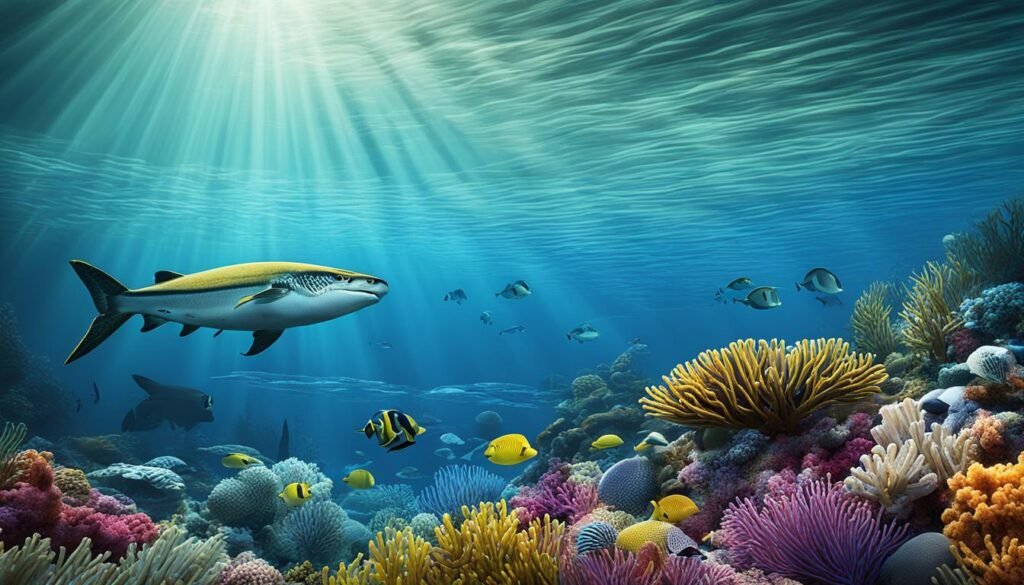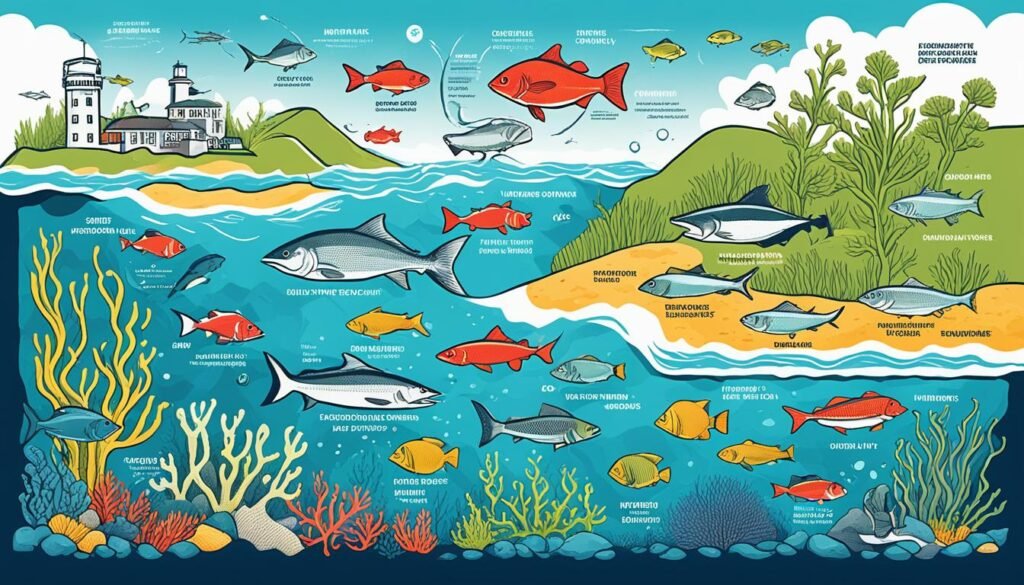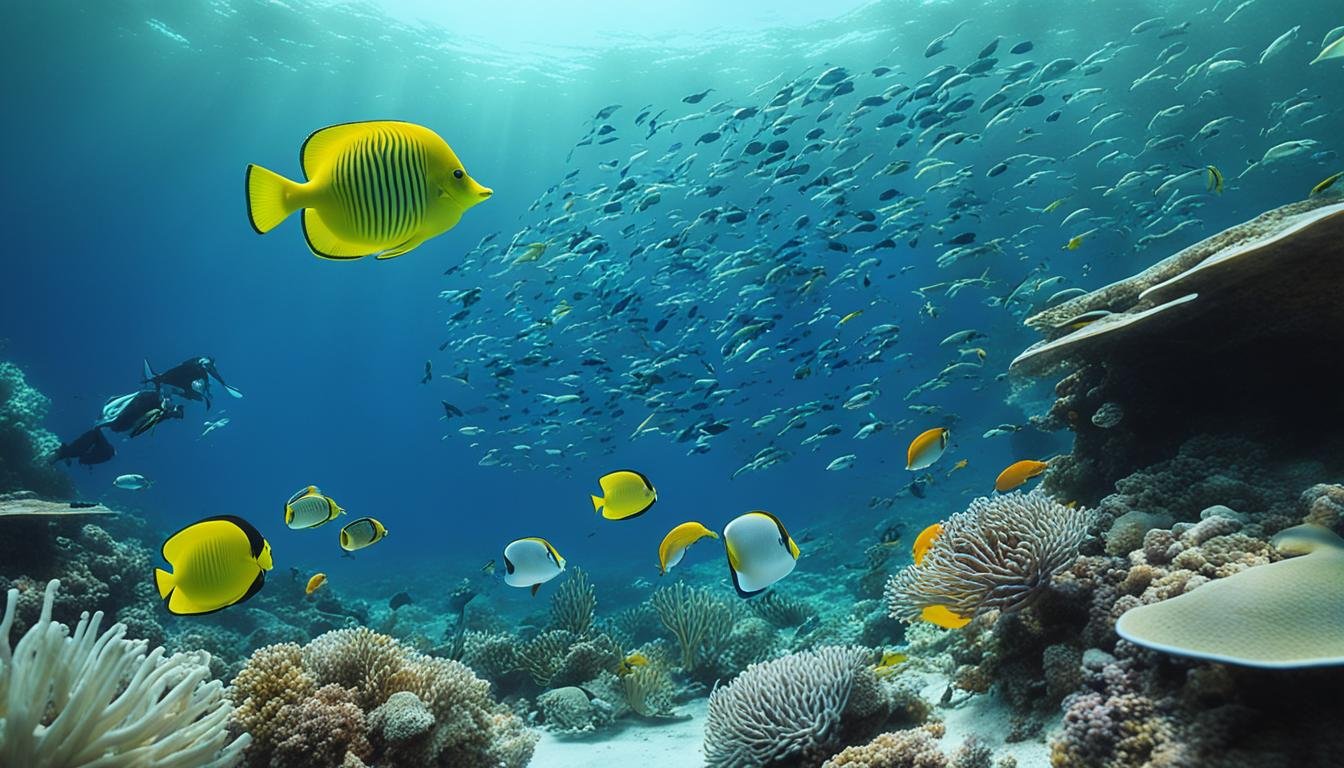Canada’s Marine Protected Areas (MPAs) have complex fishing rules. These rules aim to protect marine ecosystems while allowing sustainable resource use. But do anglers and coastal communities understand these regulations well?
Are we striking the right balance between conservation and fishing? This guide will help you navigate MPA fishing regulations.
Key Takeaways about Marine Protected Areas Fishing Regulations
- Comprehensive overview of fishing regulations within Canada’s Marine Protected Areas (MPAs)
- Understand the legal framework, stakeholder engagement, and site selection criteria for MPAs
- Explore planning and management strategies, including zoning and permissible activities
- Discover financial sustainability models and research/monitoring best practices for MPAs
- Learn how to comply with regulations and engage with coastal communities for sustainable fishing
Understanding Marine Protected Areas
Marine Protected Areas (MPAs) are special ocean zones managed to safeguard marine life. These areas protect ecosystems, habitats, and species. MPAs are crucial for marine conservation, ecosystem protection, and sustainable resource management.
MPAs help preserve biodiversity by limiting overfishing, coastal development, and pollution. They maintain key ecological processes for ocean health. Over 5,000 MPAs exist worldwide, but protection remains inadequate.
Only 5.3% of global oceans have some protection. A mere 2.5% are “highly protected”. The IUCN suggests protecting 30% of oceans by 2030 for effective conservation.
Well-enforced MPAs offer many benefits. They boost fish diversity and abundance, helping coastal communities. MPAs protect against climate change impacts by conserving ecosystems like mangroves and coral reefs.
These areas aid endangered species recovery. They also support ocean tourism, employing millions worldwide. However, nearly 60% of MPAs lack resources for effective management.
“Well-protected MPAs can safeguard against the effects of over-fishing, climate change, coastal development, and other threats, benefiting both marine life and coastal communities.”
Addressing these challenges is vital. Strengthening MPA protection and enforcement helps achieve global marine conservation targets. MPAs are key tools for ocean health and resilience.
MPAs preserve biodiversity and ensure sustainable use of marine resources. They protect important habitats and restrict harmful activities. This safeguards our oceans for current and future generations.
Legal Framework for MPAs

Oceans Act and Regulations
The Oceans Act provides the legal basis for MPAs in Canada. It allows the Minister of Fisheries and Oceans to designate protected marine areas. The Act outlines requirements for identifying, selecting, managing, and enforcing MPAs.
The federal government can establish MPAs to protect various marine resources. These include commercial fisheries, endangered species, unique habitats, and areas of high biodiversity. Effective collaboration with stakeholders is crucial for successful MPA implementation.
The Act emphasizes international cooperation for conserving migratory species. It also recognizes the need for a precautionary approach due to limited ecosystem understanding. Monitoring, adaptive management, and research are key components of MPA planning.
| Key Stakeholders in the MPA Process | Objectives and Interests |
|---|---|
| Commercial fish harvesters, recreational fishers, and related businesses | Conserve marine resources for commercial and recreational fishing |
| Indigenous communities and organizations | Conserve marine resources for cultural, subsistence, and economic reasons |
| Oil and gas companies, marine mining interests, tourism, shoreline developers, and shipping agencies | Participate in the planning and establishment process to understand the impact of MPAs on their operations |
| Other federal departments (Canadian Heritage, Environment Canada, Transport, Natural Resources Canada) | Collaborate with Fisheries and Oceans Canada to identify and manage protected areas in the marine environment |
“The publication ‘Guidelines for Marine Protected Areas’ was edited and coordinated by Graeme Kelleher in 1999, with the World Commission on Protected Areas (WCPA) playing a significant role in providing support for the creation and effective management of Marine Protected Areas (MPAs).”
The Guidelines for Marine Protected Areas stress the importance of MPAs. They are key to managing coastal and marine areas sustainably. MPAs help conserve marine heritage and biodiversity while ensuring sustainable use of resources.
These guidelines assist countries in developing MPA systems. They outline steps from planning to implementation, making the process clearer and more accessible.
Stakeholder Engagement

Stakeholder engagement is crucial for marine protected areas (MPAs). It involves consulting with coastal communities, Indigenous groups, fishers, and environmental organizations. Their input helps identify key considerations and ensures transparent planning.
Collaborative partnerships promote compliance with MPA rules and support long-term sustainability. The UK has designated 39% of its waters as protected marine areas. However, bottom-trawling was detected in 97% of UK MPAs in 2020.
Scotland aims to designate 10% of its seas as Highly Protected Marine Areas by 2026. The public consultation received over 4,000 responses. The Scottish fishing industry, which landed 63% of UK vessel tonnage in 2020, is a key stakeholder.
California’s Marine Life Management Act (MLMA) stresses collaboration with interested parties. It outlines five engagement principles: early involvement, clear goals, relationship building, openness, and inclusivity. These can guide effective stakeholder engagement in MPA management.
“Stakeholder engagement and participation are considered prerequisites for legitimacy and compliance with defined rules and regulations.”
Involving stakeholders’ opinions builds trust and leads to better MPA decisions. Community consultation, Indigenous involvement, and industry collaboration help MPAs achieve conservation goals. This approach also supports livelihoods and cultural practices of those relying on marine environments.
Site Selection Criteria

Canada’s marine protected area (MPA) site selection uses scientific and socioeconomic criteria. These identify areas of ecological significance, habitats and species, and cultural importance. The process also considers socioeconomic impacts on local industries and communities.
MPAs aim to conserve marine biodiversity and ecosystem functions. They balance environmental protection with stakeholder needs. This process uses scientific data, risk assessments, and extensive consultations.
An AOI (Area of Interest) advisory committee is key to MPA establishment. It includes Indigenous communities, industries, conservation groups, and government agencies. Their input shapes the MPA’s conservation approach.
Biophysical, socioeconomic, and resource assessments inform site selection. Inuit and Indigenous knowledge studies are also crucial. These evaluations identify areas of ecological significance and cultural value.
The MPA site selection process balances habitat protection and marine biodiversity. It carefully considers socioeconomic factors and stakeholder interests. This approach ensures effective conservation of Canada’s marine resources.
Planning and Management Strategies
Effective planning and management are vital for Canada’s marine protected areas (MPAs). They ensure long-term success through comprehensive management plans. These plans cover conservation objectives, zoning, permitted and prohibited activities, enforcement measures, and monitoring protocols.
The plans are created collaboratively. They involve stakeholders and combine scientific, cultural, and socioeconomic factors. This approach helps balance various interests and needs.
Management Plans
MPA management plans provide a framework for long-term sustainability. They include clear conservation objectives aligned with national and international goals. Detailed zoning schemes designate areas for different protection levels and activities.
The plans outline regulations for permitted activities and restrictions. They also include strategies for enforcement and compliance monitoring. Protocols for monitoring ecological, social, and economic impacts are essential components.
Provisions for periodic review and adaptive management help address emerging issues. This flexibility ensures MPAs can respond to changing environmental conditions and new threats.
- Clear conservation objectives that align with national and international goals
- Detailed zoning schemes that designate areas for different levels of protection and permitted activities
- Regulations outlining permitted activities and restrictions within the MPA
- Strategies for enforcement and compliance monitoring
- Protocols for monitoring the ecological, social, and economic impacts of the MPA
- Provisions for periodic review and adaptive management to address emerging issues
These comprehensive plans are crucial for Canada’s MPAs. They balance conservation, economic, and social priorities effectively. This approach supports the long-term success of these important marine areas.
| Key Element | Description |
|---|---|
| Conservation Objectives | Clearly defined goals for protecting marine biodiversity, habitats, and ecosystem functions |
| Zoning | Designating areas with different levels of protection and permitted activities |
| Permitted Activities | Regulations outlining activities allowed within the MPA, such as fishing, tourism, research, etc. |
| Enforcement | Strategies for monitoring compliance and enforcing MPA regulations |
| Monitoring | Protocols for tracking the ecological, social, and economic impacts of the MPA |
| Adaptive Management | Provisions for regularly reviewing and updating the management plan to address emerging issues |
“Effective planning and management are critical for the long-term success of Canada’s marine protected areas.”
Zoning and Regulations

Zoning is key in managing marine protected areas (MPAs). It balances conservation and sustainable use in protected regions. MPAs may have no-take areas, limited-use zones, and areas for specific activities.
Each zone has rules for allowed activities, catch limits, and gear restrictions. These measures protect the marine environment and its resources. Effective enforcement ensures the zoning system’s integrity.
No-Take Zones and Restricted Access
No-take zones ban extracting or disturbing marine life and habitats. These areas are sanctuaries where ecosystems thrive without human interference. Restricted access zones limit activities to reduce environmental impact.
Permitted Activities and Regulations
Some zones allow specific activities with clear rules. These may include catch limits and gear restrictions. For example, recreational fishing might be allowed with strict regulations.
“The regulations governing each zone specify the allowed and prohibited activities, catch limits, gear restrictions, and other measures to safeguard the marine environment and its resources.”
Strong enforcement is vital to maintain the zoning system. Report any unauthorized disturbance or damage to the Canadian Coast Guard. This helps protect the MPA.
A well-designed zoning framework balances conservation and sustainable use. It ensures long-term protection of Canada’s valuable marine ecosystems. This approach safeguards our oceans for future generations.
Marine Protected Areas Fishing Regulations
Canada’s marine protected areas (MPAs) have special fishing rules. These rules protect sea life and ensure fishing is sustainable. Fishers must follow these rules to help conserve marine ecosystems.
MPA fishing regulations may include several key points. Catch limits control fish size and species. Fishing permits or licenses are often required. Some fishing gear or methods may be restricted.
- Catch limits on the size and species of fish that can be harvested
- Requirements for fishing permits or licenses
- Restrictions on certain fishing gear or methods, such as the use of bottom contact gear
- Prohibitions on the disturbance, damage, or removal of any living marine organisms or their habitats
The proposed Offshore Pacific Bioregion MPA would cover 133,019 km2. It would ban activities that harm marine life or habitats. Commercial fishing with bottom gear would be banned. But ships could pass through.
Pelagic hook and line fishing near the surface would be allowed. Research and education could happen with approval. These rules aim to protect this important area long-term.
| Fishing Regulations in Canadian MPAs | Permitted Activities | Prohibited Activities |
|---|---|---|
| Catch Limits | Recreational and commercial fishing with certain size and species limits | Harvesting of fish beyond the established catch limits |
| Fishing Permits | Fishing with the required permits or licenses | Fishing without the necessary permits or licenses |
| Gear Restrictions | Pelagic hook and line fishing near the ocean’s surface | Use of bottom contact gear and other prohibited fishing methods |
| Protected Species | Scientific research, monitoring, and educational activities with approval | Disturbance, damage, or removal of any living marine organisms or their habitats |
This MPA would help Canada protect 25% of its oceans. It would safeguard 2.3% of Canada’s ocean area. The rules won’t affect tuna fishing, the area’s most profitable catch.
“The proposed Regulations aim to provide long-term, comprehensive protection to the ecologically and biologically significant area and manage activities that could impact the area negatively.”
Financial Sustainability
Long-term funding is vital for marine protected areas (MPAs) in Canada. These areas rely on various sources like government support, user fees, private partnerships, and donations. A mix of funding helps cover costs for administration, monitoring, and enforcement.
MPAs need money for community engagement and ecosystem protection. Diverse funding streams ensure MPAs can maintain their integrity over time. This approach helps shield them from budget changes.
Innovative financing can boost financial sustainability for MPAs. Trust funds, endowments, and impact investments provide steady revenue. These methods help MPAs weather changes in government budgets or donor priorities.
Strategic financial planning is key for MPAs’ long-term success. It ensures they can meet their conservation goals. This planning helps MPAs stay viable and effective.
| Funding Source | Description | Advantages | Challenges |
|---|---|---|---|
| Government Support | Allocations from federal, provincial, or territorial budgets | Stable and reliable funding; can be tailored to specific MPA needs | Subject to political and economic changes; may be insufficient to cover all MPA costs |
| User Fees | Fees for activities like fishing licenses, entry permits, and concessions | Generates revenue directly from MPA users; can incentivize sustainable use | Requires effective fee collection and enforcement; may be seen as a barrier to access |
| Private Partnerships | Collaborations with businesses, foundations, and conservation organizations | Provides additional funding sources; can leverage expertise and resources | Requires aligning interests and managing expectations; may be limited in scope or duration |
| Donations | Voluntary contributions from individuals, corporations, and philanthropic organizations | Can supplement other funding sources; helps engage the public | Unreliable and unpredictable; may require significant marketing and outreach efforts |
Canadian MPAs can boost their financial sustainability by using diverse funding sources. Innovative financing strategies help ensure their long-term success. These approaches make MPAs effective tools for marine conservation and ecosystem protection.
Research, Monitoring, and Evaluation
Ongoing research and evaluation are vital for understanding Marine Protected Areas’ (MPAs) impacts in Canada. This includes collecting scientific data on marine habitats and species. It also involves monitoring socioeconomic impacts on coastal communities and resource users.
Regular ecological monitoring within and around MPAs is crucial to assess conservation measures’ effectiveness. This involves tracking target species’ abundance, distribution, and size structure. Monitoring prey, predators, and key habitat characteristics is also important.
Fishery-independent data collection ensures reliable and comparable statistics. It helps provide accurate information about marine ecosystems and their changes over time.
Evaluating MPA performance through periodic reviews allows managers to identify successes and challenges. This adaptive management approach enables adjustments to policies for better conservation outcomes.
By continually assessing and improving MPAs, we can better protect our marine environment. This ensures a sustainable future for both ecosystems and coastal communities.
For an overview of fishing regulations and licenses in Canada, please check this guide
FAQ about Marine Protected Areas Fishing Regulations
What are Marine Protected Areas (MPAs)?
MPAs are special ocean, coastline, or Great Lakes areas. They protect marine ecosystems, habitats, and species. These areas are managed to conserve our underwater world.
What is the legal basis for establishing and managing MPAs in Canada?
The Oceans Act provides the legal foundation for MPAs in Canada. It allows the Minister of Fisheries and Oceans to create protected marine areas.
Why is stakeholder engagement important for the success of MPAs?
Stakeholder engagement is key to MPA success. It involves talking to coastal communities, Indigenous groups, and industry. This process ensures transparency and inclusivity in MPA planning.
What criteria are used to select MPA sites?
MPA sites are chosen based on several factors. These include ecological significance, sensitive habitats, and cultural importance. Potential impacts on resource-based industries are also considered.
How are MPAs planned and managed?
MPAs need thorough management plans. These plans outline conservation goals, zoning, and allowed activities. They also include enforcement measures and monitoring protocols.
How are fishing activities regulated within MPAs?
Fishing in MPAs follows specific rules. These may include catch limits and required permits. Some fishing gear or methods might be restricted to protect marine resources.
How are MPAs financed and made financially sustainable?
Long-term funding is crucial for MPAs. Money can come from government, user fees, and private partnerships. Donations also help keep MPAs financially stable.
What research and monitoring are conducted in MPAs?
Ongoing research and monitoring are vital in MPAs. These activities help us understand the areas’ impacts. They also guide adaptive management strategies for better conservation.
Source Links
- https://www.dfo-mpo.gc.ca/oceans/mpa-zpm/protection-standard-norme-protection-eng.html
- https://laws-lois.justice.gc.ca/eng/regulations/SOR-2010-190/page-1.html
- https://canadagazette.gc.ca/rp-pr/p2/2017/2017-06-14/html/sor-dors106-eng.html
- https://marine.wildaid.org/understanding-marine-protected-areas-mpas/
- https://education.nationalgeographic.org/resource/importance-marine-protected-areas/
- https://hakaimagazine.com/features/marine-protected-areas-explained/
- https://www.dfo-mpo.gc.ca/oceans/publications/mpaframework-cadrezpm/index-eng.html
- https://www.canada.ca/en/fisheries-oceans/news/2023/02/protection-standard-for-canadas-marine-protected-areas.html
- https://portals.iucn.org/library/efiles/documents/pag-003.pdf
- https://marine-conservation.org/on-the-tide/stakeholder-engagement-essential-for-successful-designation-of-highly-protected-marine-areas-in-scotland/
- https://wildlife.ca.gov/Conservation/Marine/MLMA/Master-Plan/Stakeholder-Engagement
- https://www.frontiersin.org/journals/marine-science/articles/10.3389/fmars.2022.969234/full
- https://www.dfo-mpo.gc.ca/oceans/aoi-si/index-eng.html
- https://laws.justice.gc.ca/eng/regulations/SOR-2019-105/page-1.html
- https://parks.canada.ca/amnc-nmca/gestion-management/politique-policy-2022
- https://www.dfo-mpo.gc.ca/oceans/publications/fedmpa-zpmfed/index-eng.html
- https://www.wcel.org/blog/qa-marine-protected-areas-fisheries-management


